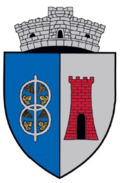Axente Sever
|
Axente Sever Frauendorf Asszonyfalva |
||||
|
||||
| Basic data | ||||
|---|---|---|---|---|
| State : |
|
|||
| Historical region : | Transylvania | |||
| Circle : | Sibiu | |||
| Coordinates : | 46 ° 6 ' N , 24 ° 13' E | |||
| Time zone : | EET ( UTC +2) | |||
| Height : | 306 m | |||
| Area : | 73.7 km² | |||
| Residents : | 3,690 (October 20, 2011) | |||
| Population density : | 50 inhabitants per km² | |||
| Postal code : | 557025 | |||
| Telephone code : | (+40) 02 69 | |||
| License plate : | SB | |||
| Structure and administration (as of 2016) | ||||
| Community type : | local community | |||
| Structure : | Axente Sever, Agârbiciu , Șoala | |||
| Mayor : | Marius Grecu ( PNL ) | |||
| Postal address : | Str. Principală, no. 308 loc. Axente Sever, jud. Sibiu, RO-557025 |
|||
| Website : | ||||
Axente Sever (outdated Frâua ; German Frauendorf , Hungarian Asszonyfalva ) is a municipality in the Sibiu district in the Transylvania region in Romania .
location
Frauendorf is located in the Sibiu district, 36 km north of Hermannstadt and 11 km south of Mediaș (Mediasch) . The village lies on the right bank of the Vișa (Weißbach) , a left tributary of the Târnava Mare (Great Kokel) . The main street runs parallel to the Weißbach. A lane leads perpendicular to it in an easterly direction. The fortified church is located at the intersection.
history
The place was first mentioned in 1305 as "Assonfalva", as a subordinate community of the Apafi family. In 1516 "Frauendorff" became a free parish of the Mediasch chair. In 1533 Frauendorf had 400 inhabitants, including 61 innkeepers, 4 widows, 2 shepherds and a miller. In 1885 a Raiffeisen association was founded in Frauendorf. The original Romanian name "Frâua", phonetically based on the German, was officially in use until 1970. Since then, the village has been named after a Romanian revolutionary (see personalities ).
Attractions
- The Protestant fortified church dates from the 14th century.
The church, first mentioned in 1322 as the "Church of All Saints", was built in two construction phases. The original church is a high Gothic hall church, built from quarry and river stone. In a very rare design, a three-storey bell tower was built above the choir square. The thickness of the tower wall is 1.6 m on the ground floor. In the south of the tower there are remains of a chapel. Access to the upper floors is via a bustard built into the western wall. In 1490 the church was rebuilt for defense. One of the most imposing fortified churches in Transylvania was built. The hall and choir walls were raised about two floors, creating space for defensive floors. The ascent in the west wall was provided with a portcullis, the gutters of which can still be seen. At the same time, the bell tower was converted into a mighty bulwark and incorporated into the defense complex. This also includes the egg-shaped bering (circular wall), the walls of which are between 6 and 8 m high. Under the pent roof sloping down towards the courtyard there were living rooms and pantries. Each chamber has its own entrance and is connected to the battlement under the pent roof through an opening in the ceiling. From here the loopholes and pouring holes were operated.
In the second half of the 18th century, an organ gallery was built on the west side of the church, with angels playing music on the parapet. A wooden gallery was built on the south and north walls.
The baroque altar was made by Stephan Valepagi in 1777. The main picture depicted Christ crucified, at whose feet Mary, his mother, and the disciple Johannes. Two Corinthian columns frame the apostles Paul and Peter on the right and left. Under the crucifixion table, on the predella , there is a picture of the Lord's Supper , and the conclusion in the upper picture shows the risen One. The brick pulpit is adorned with two images of saints.
In 1777 the organ builder Johann Hann from Sibiu built a baroque organ, which was converted into a pneumatic organ by the Ludwig Wegenstein company in 1926. There are three bells in the bell tower. The big bell from 1699 bears the inscription: "Gloria in excelsis deo et in terra pax hominibus".
In 1964 the church and fortified church were extensively renovated. The church was badly damaged in a storm on August 4, 2009.
Personalities
- Ioan Axente Sever (1821-1906), politician, revolutionary and participated in the leadership of ASTRA (Transylvanian Association for Romanian Literature and the Culture of the Romanian People)
See also
literature
- Arne Franke: The defensive Sachsenland. Fortified churches in southern Transylvania. With a historical introduction by Harald Roth. German Cultural Forum for Eastern Europe, Potsdam 2007, ISBN 978-3-936168-27-3 .
Web links
- Axente Sever at ghidulprimariilor.ro
- Frauendorf at sevenbuerger.de
- Wilhelm Roth: Flower Festival in Frauendorf ("Fuasenichdunz mät den Gepeschker" 1982)
Individual evidence
- ↑ 2011 census in Romania at citypopulation.de
- ↑ Siebenbürgische Zeitung of September 14, 2009, accessed on September 14, 2009
- ↑ Ecatarina Țarălungă: Romanian personalities (online, see under Axente, Ioan ) ( Memento from 23 September 2015 in the Internet Archive ) or Ecaterina Țarălungă: Enciclopedia identității româneşti. Personalități , Bucureşti, Editura Litera, 2011, ISBN 978-606-600-246-2 .







